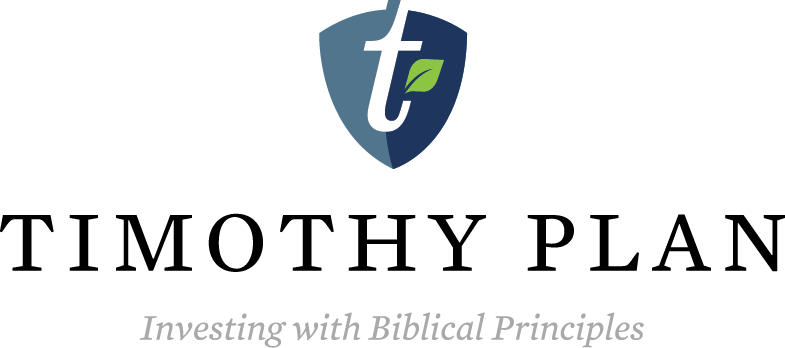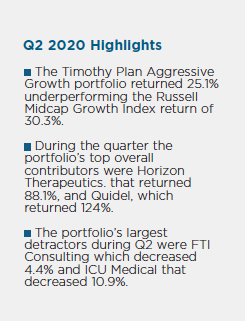Aggressive Growth 2Q20
September 15, 2020
Recent Posts
- A Businessman Who Really Did Give it All Over to GodSeptember 28, 2022
- A 'Screwtape' Approach to Keeping Christians from Biblically Responsible InvestingSeptember 21, 2022
- Both Inflation and Inaction Are UnbiblicalSeptember 14, 2022
- Misunderstood in the NeighborhoodAugust 18, 2022
- Billy Graham was the inspiration for the new BiblegraphAugust 9, 2022
- A Businessman Who Really Did Give it All Over to God
Categories

Investing involves risk, including the potential loss of principal.
Before investing, carefully consider the fund’s investment objectives, risks, charges, and expenses of the investment company. This and other important information can be found in the fund’s prospectus. To obtain a copy, visit TIMOTHYPLAN.COM or call 800.846.7526. Read each prospectus carefully before investing.
Because the Timothy Plan Funds do not invest in excluded securities, the Funds may be riskier than other funds that invest in a broader array of securities. There are risks when a fund limits its investments to particular sized companies, and all companies are subject to market risk. The Fund recently experienced significant negative short-term performance due to market volatility associated with the Covid-19 pandemic.
MUTUAL FUND INVESTOR
To read more about our mutual funds, please click this link to access fund information, including the prospectus, fact sheets, performance, and holdings for each fund.A prospectus is available from the Fund or your financial professional that contains more complete, important information. Please read it carefully before investing. Mutual Funds distributed by Timothy Partners, Ltd. Member FINRA.
HEADQUARTERS: 1055 Maitland Center Commons, Maitland, FL
(800) 846-7526 | Send an email | View our mapMUTUAL FUND SHAREHOLDER SERVICES: c/o Ultimus Fund Solutions, Post Office Box 541150, Omaha, NE 68154-1150
(800) 662-0201 | Account AccessETF INVESTOR
To read more about our ETFs, please click this link to access fund information, including fact sheets, performance and holdings for each fund. A prospectus is available from the Fund or your financial professional that contains more complete, important information. Please read it carefully before investing. ETFs distributed by Foreside Fund Services, LLC, Member FINRA. Timothy Partners, Ltd. is not affiliated with Foreside Fund Services, LLC.
ETF SHAREHOLDER SERVICES: Contact your financial advisor for information regarding your account.






Macroeconomic Update
From the depth of despair in late March throughout the second quarter the U.S. economy began its recovery. The aggregate data however masks the unevenness of that recovery. Industries with underlying demand that had curtailed operations as a precautionary measure against the COVID-19 virus, such as manufacturing and construction, had very different rebound dynamics than those industries that had demand evaporate as a result of the virus, such as travel, leisure, and entertainment. As of July 2, 2020, the Atlanta Federal Reserve’s GDPNow™ estimates Q2 2020 growth at negative 35.2% percent, the largest quarterly decline in economic growth in US history. The severe late-March collapse did not reverse course until mid-May as certain states began easing “stay-at-home” restrictions. The Institute for Supply Management Manufacturing index (June 2020 Manufacturing ISM®) which had troughed at 41.5 in April finally made its way back into expansionary territory with the June release at 52.6. Similarly, the Non-Manufacturing (services) index (June 2020 Non-Manufacturing ISM®) snapped back from a low of 41.8 in April to 57.1 in June. The New Orders and Business Activity sub-components led the move into expansionary territory but, as with the Manufacturing Index, the Employment sub-component remained in contraction. It should be noted that both of these surveys are conducted during the middle of the month, so the June readings do not incorporate the virus resurgence in some of the larger re-opening states.
Although the supply side of the economy showed an unprecedented decline from February to April, the demand side of the economy contracted even more severely. In April alone, more than 20 million people filed for initial unemployment claims. That was on top of the more than 13 million fi ling claims in February and March of this year. The fact that average hourly earnings spiked nearly 8% in April despite the decline in employment indicated that lower wage workers bore the brunt of the job losses. As states began to loosen stay-at-home restrictions in May and June, employment began to recover with over 7 million jobs added in those two months. The unemployment rate remains (as of July, 2020) at an elevated level above 11% though and the underemployment rate is at 18%. As important as the loss of jobs, personal spending also fell precipitously, down nearly 14% in April alone before partially rebounding in May on state re-openings. The fact that the incidence of COVID-19 has resurged and restrictions have been instituted or reinstituted puts the employment and spending improvements in jeopardy over the coming months.
This recession is proving to be confounding, as its effects are highly concentrated among certain industries. The food service, transportation, and hotel industries have been bludgeoned by COVID-19, and the job loss has been dramatic in these industries. However, the average median income for employees in those sectors are less than half of the U.S. median income; as a result, aggregate personal spending hasn’t been impacted dramatically. Actually, several industries such as the homebuilding and automobiles has posted favorable sales results over the past two months. The big caveat to this recovery is obviously the nascent spike of cases in 25 states since quarter end, with particularly concerning data emerging from Florida, Texas, Arizona and California.
Q2 2020 Review
The Timothy Plan Aggressive Growth Fund returned 25.1% in Q2, underperforming the Russell Midcap Growth Index return of 30.3%. Performance in most of the sectors was relatively in line with the benchmark except for the Technology sector and the Consumer Discretionary sector, where subpar stock selection led to underperformance. The largest contributor to the relative underperformance was the cash weighting, which averaged 7.6% in Q2. YTD the cash weighting still has been a positive contributor to relative performance.
There was a meaningful shift in investors psychology in Q2, where the largest relative outperformers in Q1 became the largest relative underperformers in Q2. Specifically, there is a widespread ‘economic rebound’ trade occurring, with investors rushing into consumer discretionary and technology sectors. Whether that mindset continues as the US is dealing with record number of COVID-19 cases, as well as a likely second wave this fall, is the key question.
Contributors
The Fund’s top overall contributor on a relative basis during Q2 2020 was Horizon Therapeutics (3.2% avg. weight)1, which returned 88.1% during Q2. During Q2, Horizon Therapeutics launched Tepezza for the treatment of Thyroid Eye Disease. Despite very difficult launching conditions [launching a drug in the midst of a pandemic], the drug has seen extremely high demand, and Horizon Therapeutics has already raised guidance for 2020 sales twice over the past few months. We believe that the visibility and upside for Horizon is still significant, and it is the largest position within the portfolio.
Another strong performer was Quidel (2.1%) which returned 124% during Q2. Quidel is an established healthcare diagnostic company that reacted quickly to the pandemic and launched a COVID-19 PCR antibody test and an antigen diagnostic. Quidel is working on combining their flu assays with COVID ahead of this upcoming fall flu season; that 15-minute test should be in very high demand for the next year.
Detractors
As mentioned earlier, the Fund’s largest detractors were stocks that had the highest relative outperformance in Q1. Specifically, FTI Consulting (2.95%) decreased 4.4% while ICU Medical (1.0%), decreased 10.9% in Q2. For FTI Consulting, the stock fell out of favor as investors clamored for companies in the economic recovery basket. We still believe FTI Consulting will experience higher demand for their financial restructuring division, given the dramatic amount of financial restructurings and bankruptcies that will be brought on post the pandemic.
Regarding ICU medical, there were high hopes that the company would experience increased demand for their infusion pumpsets due to COVID, however capital sales cycles in hospitals have been dramatically negatively impacted by COVID, which led to a disappointing earnings release for ICU.
Market Outlook
Perhaps more so than at any other times, visibility is extremely limited. The market selloff of 34% in five weeks was stunning, but perhaps the market recovery has been even more stunning. The Nasdaq is setting new all-time high records, and the Russell 2000 Growth index has nearly regained all its earlier losses in record time, just in two months.
In hindsight, the Federal Reserve Credit Facilities and Lending programs have proven to be extremely effective, particularly in reassuring investors that the Fed will be extremely creative and aggressive in stimulating the economy and supporting both the equity and credit markets.
As it relates to our expectations for the rest of 2020, it all circles back to how long COVID-19 will impact the economy. (Yes, that is the exact sentence used in the Q1 commentary). However, we have become much more optimistic here. The pace and initial data for the vaccine programs under development are astonishingly positive, and we now believe that vaccines will be available under Emergency Use Authorization in Q4, with wider availability in the spring of 2021. Thankfully the structure of the COVID-19 virus is well defined, allowing vaccine developers to develop effective vaccines in record times. We were initially overly pessimistic in development timelines, anchoring our expectations on prior vaccine development timelines. The only caveat is it’s quite possible that this vaccine will have efficacy rates of 50-70%, not 99% as seen with other vaccines. Therefore, it will be necessary for a large percentage of the population to be vaccinated in order to reach herd immunity. However, we believe that the market will respond favorably to the near-term clinical data that will be published over the next two months. We are repositioning the portfolio in anticipation of these developments.
We continue to find compelling investment opportunities, particularly in the consumer discretionary sector. We are considering investments in the retail and travel related industries, as we believe that investors will look past near-term weak results towards normalized operations in 2021 and 2022. We remain focused on generating alpha and producing the strongest investment results over the long run.
The securities identified and described do not represent all of the securities purchased, sold or recommended for client accounts. The reader should not assume that an investment in the securities identified was or will be profitable. The Index returns are provided to show an example of alternate return potential during the relevant time periods; however, indices may possess different investment attributes that may make comparisons difficult such as volatility, liquidity, market capitalization, and security types. The statistical data regarding the indices has been obtained from Bloomberg and the returns are calculated assuming all dividends are reinvested. The indices are not subject to any of the fees or expenses to which the portfolios are subject. This report assumes the reader has sophisticated knowledge of investing and the markets. If you require more information about the information presented, including the portfolio characteristics and risk statistics, please contact us.
Manager views expressed herein were current as of the date indicated above and are subject to change. It should not be assumed that recommendations made in the future will be profitable or will equal the performance of the securities in this commentary. A copy of the calculation methodology and the full list of recommendations made in the preceding year is available upon request. The performance data quoted represents past performance and does not guarantee future results. Performance returns quoted are gross of fees which were calculated on a time weighted basis and do not give effect to investment advisory fees, which would reduce such returns. Please see Chartwell’s Form ADV, Part II for a complete description of investment advisory fees. The following statement demonstrates the compound effect advisory fees have on investment returns: For example, if a portfolio’s annual rate of return is 15% for 5 years and the annual advisory fee for a client is 100 basis points or 1.00%, the gross cumulative 5 year return would be 101.1% and the five year return net of fees would be 92.5%. Actual fees charged to portfolios may be different due to various conditions including account size, calculation method and frequency, and the presence of a performance or incentive fee. The deduction of performance and incentive based fees will have similar, yet often larger, impacts to performance and account values than standard management fees. To receive a complete list and description of Chartwell Investment Partners’ composites, performance attribution for all securities, and/or a presentation that adheres to the GIPS® standards, please contact Lynette Treible by phone (610)407-4870, email [email protected], or by mail to 1205 Westlakes Drive, Suite 100, Berwyn, PA 19312.